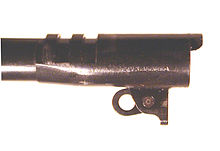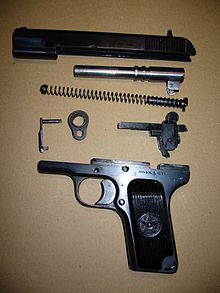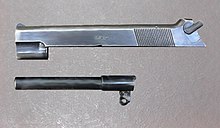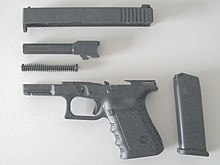Browning system
The Browning system (also Glock system ) is a locking system for self-loading pistols . It enables the use of ammunition for which an unlocked ground lock is too weak. The main characteristic is a barrel that is not permanently connected to the frame, which locks positively with the upper bolt housing when the weapon is ready to fire. The Browning system is used to this day - partly in an improved form - and is the main locking system found in self-loading pistols.
history
This bis system was invented by the American John Moses Browning (1855–1926). The first self-loading pistol with this locking system, the Colt Model 1900 , came onto the market as early as 1900 . The best known application is the Colt M1911 ("Colt Government").
Compared to other systems, the Browning system is particularly impressive because of its simplicity. The system is insensitive to dirt and dust and has proven to be extremely reliable. The production costs are relatively low compared to other modern locking systems.
Well-known representatives of variants of this design are the FN High Power , the SIG P210 , Walther P99 and the Glock pistol .
functionality
At the moment the shot is released, the barrel and breech (also known as the "slide") form a unit, as they are connected to one another by means of two locking combs on the barrel and corresponding grooves in the breech. After the shot has been released, both are accelerated backwards by the gas pressure . Since the rear end of the barrel is articulated to the handle via a chain link , it is tilted downwards with advancing backward movement and the locking combs shear out of the grooves of the lock. The system is unlocked. The run is stopped by hitting the bearing block against the abutment of the handle in the return. The section necessary to separate the barrel and breech is called the underlay section. It is required to keep the system locked until the gas pressure has released. Due to the kinetic energy given to it, the breech moves backwards and takes the fired cartridge case with the extractor claw until it hits the ejector and is thrown out of the ejection window . In the further return, the breech cocks the recoil spring and the trigger mechanism of the weapon. At the rear dead center reached, the shutter is driven by the closing spring forward again, increases with the impact plate from the magazine nachgerutschte the cartridge with and feeds them into the cartridge chamber a. The barrel is then taken along again and brought back up to its starting position by the chain link and the guide cam at the front of the bearing block. The weapon is locked again and ready to fire.
Originally the barrel was connected to the handle with two chain links, one at the front and one at the back of the barrel. When reversing it was pulled down in parallel, these weapons are therefore called parallel rulers . The first Browning pistol mass-produced by Colt with this system was the Colt Model 1900 , the last of its kind was the Colt Military Model of 1905 .
Further developments
Later designers replaced the chain link with a control link, others replaced the locking combs with the block-shaped barrel end that locked directly in the case ejection window.
Locking combs with chain link (Tokarev pistols)
The Tokarev pistols TT-30 and TT-33 could use the unchanged Browning system after the expiry of the Colt patents. With the later TT-33, one machining step was saved by running the locking combs around the entire barrel circumference.
Locking combs with control link (Browning FN system)

As part of his later work for the FN Herstal Belgian, Browning developed a new version of his system before 1928 so as not to infringe the Colt 1911 patents. The functional principle remains the same, but the barrel is no longer unlocked via a movably mounted chain link, but by means of a control cam that is fixed to the barrel. The control curve was already open at the bottom. With a closed control cam, this system was manufactured in large series as FN Browning HP from 1935 .
Locking block with chain link (Saint-Étienne model 1935S)
While the self-loading pistol model 1935A developed by Charles Petter at Société Alsacienne de Constructions Mécaniques (SACM) used the unchanged Browning system , the system was simplified in the parallel development of the Société Manufacturière d'Armes Saint-Étienne , self-loading pistol model 1935S , so that the Locking takes place via a bead-like thickening of the barrel in the case ejection window of the slide. At the rear, a lug in the cartridge chamber was used to form-fit against the bottom of the slide. The barrel is still connected to the frame by a chain link.
Locking block with control link (modified Browning system)
In the early / mid-1940s, the Swiss Industrial Association (SIG) bought the rights to the “S” version with shoulder lock, but did not use it for the time being. In the development of the later Swiss army pistol ( SIG P210 ), which began in 1942 , curiously, the Browning FN system with two locking combs and a closed control link was used again. Apparently the SIG still classified this system as the higher quality one. It was not until the mid-1970s that the shoulder lock of the “S” variant was then used in the Pist 75 / SIG P220 and has therefore since been assigned to the SIG as the “SIG-Sauer-System” or “Browning-SIG-System”. Historically, this is not entirely correct, as this system was originally a development by MAS in St. Etienne / France.
The system introduced with the SIG P220 combines the locking block of the St.-Étienne model 1935S with the control link of the Browning FN system, whereby the locking block is cuboid and by means of a very precisely designed locking shoulder in the slide at the front and at the rear with a mostly relatively wide one Latch locked in the bumper. As in Browning's patent from 1927, the control link below the cartridge chamber is no longer closed, but open: Instead of the axis of the slide stop lever through the closed link, a correspondingly shaped, flat link below the cartridge chamber controls another level with a corresponding level that is firmly integrated in the handle Characteristic of the lowering of the barrel - and thus the unlocking. This system is easier to manufacture and has increased wear resistance due to the better distribution of force in the locking shoulder. The flat, straight connections and surfaces can be produced easily and with high precision using CNC production. However, this type of closure requires the use of very high quality steels.
It is used in all modern pistols from Glock , Steyr Mannlicher and Walther .
Browning pistols with ground lock
The pocket pistols manufactured by Browning since the turn of the century in the 6.35 mm Browning caliber and the slightly larger pistols in the 7.65 mm Browning and 9 mm short caliber do not have a locking mechanism - they have a ground lock . The first of these pistols to hit the market was the Belgium-made FN Browning Model 1900 and FN Browning Model 1910 , in the US it was the Colt Model 1903 Hammerless . In these pistols, the barrel is rigidly mounted in the handle and the slide is only held in the foremost position by the recoil spring. The reloading process corresponds to that of the locked pistols with the difference that the barrel does not move backwards.
When firing, the slide is accelerated backwards by the gas pressure acting on the case. The acceleration depends on the gas pressure as well as the ratio of the mass accelerated to the front (bullet plus ~ 1/2 gas weight) to the breech mass accelerated backwards according to the law of conservation of momentum . Due to the sealing compound, the acceleration distance is significantly shorter than the cylindrical sleeve, which ensures the ligation . In the further return, the lock is braked by the closing spring and brought forward again for reloading. It should be noted that the closing spring has only an insignificant influence on the acceleration phase of the closure in relation to the closure mass.
literature
- Edward Clinton Ezell: FN Browning selfloading pistols, 1894 to 1945 (history of development and models) in Handguns of the world: military revolvers and self-loaders from 1870 to 1945 , Barnes & Noble, New York, 1993, pages 202 ff. Full text online , ISBN 978-0-88029-618-2 .
- Günter Heuberger: Locking systems for pistols. (Pdf, 27 kB) p. 2 , accessed on May 19, 2017 .
- Günter Wollert, Reiner Lidschun, Wilfried Copenhagen : small arms . (1945-1985). In: Illustrated encyclopedia of rifles from around the world . 5th edition. tape 1 + 2 . Brandenburgisches Verlagshaus, Berlin 1988, ISBN 3-89488-057-0 , weapons, p. 334, 335 .
- Christian Reinhart, Jürg A. Meier: Pistols and revolvers in Switzerland since 1720 . Verlag Stocker Schmid, Dietikon Zurich 1998, ISBN 3-7276-7128-9 .
- Paul M. Barrett: Glock. The Rise of America's Gun . Crown Publishing Group , New York 2012, ISBN 978-0-307-71995-9 (English).
Web links
Individual evidence
- ↑ John M. Browning: US1618510A. (PDF) February 22, 1927, accessed July 29, 2019 .
- ^ Günter Heuberger: Locking systems for pistols, pages 2 to 3.






